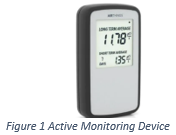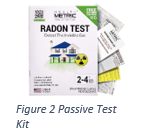Radon exposure is the second leading cause of lung cancer overall and leading cause of lung cancer for non-smokers
Exposure to radon is one of the leading contributors to lung cancer, yet many people aren’t aware that they can mitigate their risk by testing their homes. Radon is a naturally occurring gas that originates in the soil. It is emitted from the soil and can buildup in confined spaces, buildings, new homes, old homes, well-sealed homes, basements, crawl spaces, and homes or buildings built on slabs.
Nearly one out of every 15 homes in the U.S. is estimated to have an elevated radon level. Radon is not detectable and does not cause noticeable symptoms until it develops into lung cancer. When an individual breathes in radon, the gas enters the lining of your lungs and gives off radiation. Over a long period of time, this can damage the cells in your lungs and lead to lung cancer. Not everyone exposed to high levels of radon will develop lung cancer and the onset of the disease could be many years. Also, radon exposure does not cause any short-term effects such as coughing, fever, or headaches.
Test your home for radon-it’s easy and inexpensive. You should test your home’s radon levels if it’s never been tested, when preparing to buy or sell, or before and after any renovations.
 There are two main types of radon detection kits for short-term testing, which are active and
There are two main types of radon detection kits for short-term testing, which are active and passive tests. Passive tests do not need power to function and require a sample that is sent to experts for analysis. A short-term passive test would be a sampling from 2-90 days and a long-term passive test would be greater than 90 days. The second type of testing would be an active test. These require a power to function and can provide a reading almost instantly. They are usually more expensive and require operation by trained testers.
passive tests. Passive tests do not need power to function and require a sample that is sent to experts for analysis. A short-term passive test would be a sampling from 2-90 days and a long-term passive test would be greater than 90 days. The second type of testing would be an active test. These require a power to function and can provide a reading almost instantly. They are usually more expensive and require operation by trained testers.
Average indoor levels of radon are 1.3 pCi/L (picocuries per liter). Levels 4.0 or higher require mitigation. Mitigation is typically a vent pipe system and fan which pulls radon from beneath the building or house and vent the gas outside of the space. Standard mitigation systems are usually effective within 24 hours and will maintain as long as a fan is constantly operating.
|
What to do with your test results |
|
|
Radon Level |
Action |
|
Higher than 4pC/L |
|
|
Between 2pCi/L and 4pCi/L |
|
|
Lower than 2pCi/L |
No action needed. Test again if you meet any testing suggestion requirements. |
Related Topics: Environment, Safety Hazards, Home Safety, Confined Spaces, Safety Articles, Monthly Safety Topics